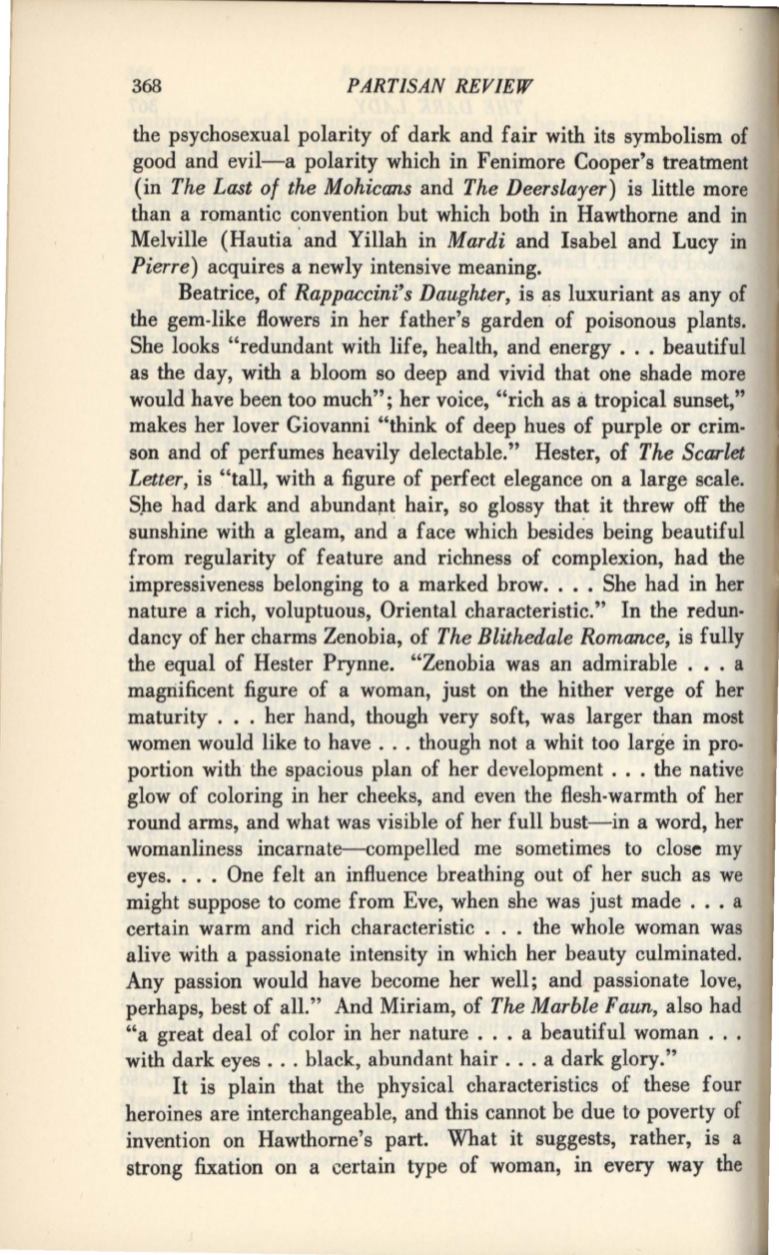
368
PARTISAN REVIEW
the psychosexual polarity of dark and fair with its symbolism of
good and evil-a polarity which in Fenimore Cooper's treatment
(in
The Last of the Mohicans
and
The Deerslayer)
is little more
than a romantic convention but which both in Hawthorne and in
Melville (Hautia ·and Yillah in
Mardi
and Isabel and Lucy in
Pierre)
acquires a newly intensive meaning.
Beatrice, of
Rappaccini's Daughter,
is as luxuriant as any of
the gem-like flowers in her father's garden of poisonous plants.
She looks "redundant with life, health, and energy ... beautiful
as the day, with a bloom so deep and vivid that one shade more
would have been too much"; her voice, "rich as
a
tropical sunset,"
makes her lover Giovanni "think of deep hues of purple or crim·
son and of perfumes heavily delectable." Hester, of
The Scarlet
Letter,
is "tall, with a figure of perfect elegance on a large scale.
She had dark and abundap.t hair, so glossy that it threw off the
sunshine with a gleam, and a face which besides being beautiful
from regularity of feature and richness of complexion, had the
impressiveness belonging to a marked brow.... She had in her
nature a rich, voluptuous, Oriental characteristic." In the redun·
dancy of her charms Zenobia, of
The Blithedale Romance,
is fully
the equal of Hester Prynne. "Zenobia was an admirable . . . a
magnificent figure of a woman, just on the hither verge of her
maturity . . . her hand, though very soft, was larger than most
women would like to have ... though not a whit too large in pro·
portion with the spacious plan of her development ... the native
glow of coloring in her cheeks, and even the flesh-warmth of her
round arms, and what was visible of her full bust-in a word, her
womanliness incarnate-compelled me sometimes to close my
eyes. . . . One felt an influence breathing out of her such as we
might suppose to come from Eve, when she was just made ... a
certain warm and rich characteristic . . . the whole woman was
alive with a passionate intensity in which her beauty culminated.
Any passion would have become her well; and passionate love,
perhaps, best of all." And Miriam, of
The Marble Faun,
also had
"a great deal of color in her nature ... a beautiful woman ...
with dark eyes ... black, abundant hair ... a dark glory."
It is plain that the physical characteristics of these four
heroines are interchangeable, and this cannot be due to poverty of
invention on Hawthorne's part. What it suggests, rather, is a
strong fixation on a certain type of woman, in every way the


